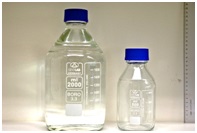Radioactivity measurements in the marine environment which are performed mainly for radioprotection and radioecology purposes. Also, radio-tracing techniques are utilized in several oceanographic, geophysical, hydrogeological applications. The gamma-ray spectrometry team of the Hellenic Centre for Marine Research (HCMR) utilizes technologically enhanced instrumentation along with advanced methodologies contributing to the research activities of the Institute of Oceanography (IO). Both laboratory and in-situ techniques are applied.
1) Laboratory techniques
The gamma-ray spectrometry team maintains and operates a High Purity Germanium Detector (HPGe) for precise measurements of radioactivity concentrations in samples of seabed sediment and seawater. Small quantities of sediment and water in specific geometries are measured by the HPGe detector to obtain the activity concentration (in Bq/kgr or Bq/l) of the most important natural (e.g. uranium 238U progenies, thorium 232Th progenies, potassium 40K) and anthropogenic radionuclides (e.g. cesium 137Cs, iodine 131I). The accuracy of the followed methodology for sediment measurements has been confirmed by inter-comparison exercise of the International Atomic Energy Agency (IAEA-385).

|
For caesium and radium detection in seawater, pre-concentration procedures are performed prior the measurement, while quite recently a rapid method for direct radon/thoron progenies in groundwater has been developed and published. Radio-tracing applications:
- Seawater movement (137Cs)
- Sedimentation rate (210Pb, 137Cs, 228,226Ra)
- Sediment dating (210Pb, 226Ra)
- Localization of Submarine Groundwater sources (222,220Rn progenies)
- Quantitative estimation of groundwater discharge in coastal areas (radium isotopes)
- Investigation of groundwater processes e.g. residence time (224,226Ra)

|

|
The in-situ technique (when the detection instrument is placed itself over or directly in contact with the study environment) provides data rapidly, without user surveillance and offers the advantage of continuous monitoring. The IO-HCMR has developed a "state-of-the-art" underwater gamma-ray spectrometer (called "KATERINA") capable to operate down to depth of 700m and provide quantitative results of radioactivity concentration in seawater. This novel system is a Greek patent (patent number ...) and is supplemented by unique features as multiple deployment modes (autonomous, integrated onto mooring measuring platforms, attached on remote operated vehicles), reliable long-time operation due to stabilization of electronic performance and robustness. So far, KATERINA has been deployed for geophysical applications like radon monitoring close to active seismic faults (L'Aquila -Italy and Marmara strait-Turkey), for hydrogeological purposes monitoring radon/thoron progenies and potassium onto submarine groundwater springs (Stoupa and Korfos-Greece, Monaco-France) and for radio ecological surveys.

|

|

|
Benefits of in-situ techniques
- Real-time or remote monitoring of seawater providing time-series of data for radio-ecological purposes (e.g. straits, river estuaries, lakes)
- Rapid radionuclide mapping of seabed for localization of pollution "hot-spot"
- In-situ time series of data may be used to verify models of radionuclide oceanic movement
- Monitoring of radioactive gases (222,220Rn) emanation rates for marine geology purposes (investigation of submerged volcanoes, active seismic faults, geothermal sources)
- IProvides rapidly quantitative results supporting radiological early warning systems
 Hellenic Centre for Marine Research
Hellenic Centre for Marine Research